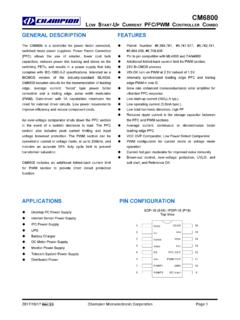Transcription of SETTING HIGH ACADEMIC EXPECTATIONS - Teach Like a Champion
1 Lemov V3 - 02/08/2010 12:05pm Page 27 CHAPTER ONESETTING HIGHACADEMICEXPECTATIONSOne consistent finding of ACADEMIC research is that high EXPECTATIONS are the mostreliable driver of high student achievement, even in students who do not havea history of successful achievement. Much of this research has been conductedto test, confirm, or debunk the famous Pygmalion study in which teacherswere told that randomly selected groups of students had been proven throughtesting to be on the brink of great ACADEMIC gains. Those groups of randomlyselected students in fact outperformed other randomly selected groups whoseteachers had not been led to expect great things, presumably because of of the problems with findings about high EXPECTATIONS is that they ofteninclude in the definition a wide array of actions, beliefs, and operational study definedhigh expectationsas including the decision to allocate andprotect more time on task in ACADEMIC subjects.
2 That s certainly good policy,but from a research standpoint, it s hard to disaggregate the effect of more timeon task from EXPECTATIONS . It s also hard to turn that into specific action in what are the concrete actionable ways that teachers who get exceptionalresults demonstrate high EXPECTATIONS ? This chapter looks at five, derived fromShortLong27 Lemov V3 - 02/08/2010 12:05pm Page 2828 Teach Like a Championthese teachers, that raise EXPECTATIONS and differentiate great classrooms from themerely good 1NO OPT OUTOne consistency among Champion teachers is their vigilance in maintaining theexpectation that it s not okay not to try. Everybodylearns in a high -performingclassroom, and EXPECTATIONS are high even for students who don t yet havehigh EXPECTATIONS for themselves. So a method of eliminating the possibilityof opting out muttering, I don t know, in response to a question or perhapsmerely shrugging impassively in expectation that the teacher will soon leave youalone quickly becomes a key component of the classroom culture.
3 That s whereNo Opt Outstarted, though as with so many of the other techniques in this book,it soon found additional applications as a useful tool for helping earnest, strivingstudents who are trying hard but genuinely don t know the Opt Outhelps address both. At its core is the belief that a sequence beginning with astudent unable (or unwilling) to answer a question should end with that studentgiving the right answer as often as possible, even if it is only to repeat the correctanswer. Only then is the sequence IDEANO OPT OUTA sequence that begins with a student unable to answera question should end with the student answering thatquestion as often as its simplest form,No Opt Outmight look like this. It s the first day ofschool, and you re reviewing multiplication facts with your fifth or perhaps sixthgraders. You ask Charlie what 3 times 8 is. Glancing briefly and impassively atyou, Charlie mutters, I dunno, under his breath, then sucks his teeth, and turnsShortLongLemov V3 - 02/08/2010 12:05pm Page 29 SETTING high ACADEMIC Expectations29 Reluctant students quicklycome to recognize that I don t know is the Rosettastone of work head slowly to look out the s a critical moment.
4 Students all toocommonly use this approach to pushback on teachers when their unwilling-ness to try, a lack of knowledge, ora combination of the two makes themunsure or resistant. And all too often itworks. Reluctant students quickly come to recognize that I don t know is theRosetta stone of work avoidance. Many teachers simply don t know how torespond. The result is a strong incentive for students to say, I don t know when asked a question. If you don t feel like working hard, those three wordscan save you a lot of effort. So if Charlie successfully shows you that you can tmake him participate, it s going to be a long year of you gingerly (and weakly)stepping around him, of other students seeing that Charlie does what he wants,and of Charlie not learning a lose-lose-lose you usedNo Opt Outin this situation, you would turn to another student,Devon, and ask him that same question.
5 Assuming he correctly answered 24,you d now turn back to Charlie: Now you tell me, Charlie, what s 3 times 8? Charlie has just found without your stopping for a time-consuming and possiblyineffective lecture that he has to do the work anyway in your class. Later we lllook at more challenging contingencies that you may be wondering about: Whatif Charlie doesn t answer when you come back to him? What if Devon doesn tanswer? For now, it s most important just to understand the power and necessityof coming back to a student who won t try. The moment when you circle backand ask the student to reanswer the original question is theNo Opt Opt Outproves to be just as powerful in situations where students aretrying. Here s an example from Darryl Williams s classroom, in which a student,James, was unable to identify the subject of the sentence, My mother wasnot happy. He first tried to guess: Happy?
6 He asked. Williams persevered,repeating the question as many other teachers would do: What s the subject? However, as the student was still unable to answer, Williams now asked theclass, When I am asking you for the subject, what am I asking for? Thestudent he called on now replied, You re asking for who or what the sentenceis about. Returning to James, Williams repeated, When I ask for the subject,I am asking for who or what the sentence is about. What s the subject? Jamesnow answered correctly: Mother. As in all otherNo Opt Outs,the sequencebegan with a student unable to answer and ended with him providing the second student s answer didn t replace the original student s; it supportedShortLongLemov V3 - 02/08/2010 12:05pm Page 3030 Teach Like a Championit. And James has seen himself succeed where just moments ago he was unableto. He has rehearsed success and practiced one of the fundamental processes ofschool: get it wrong; then get it let s return now to some thoughts about what you might do if thingshadn t gone so well.
7 What if James still couldn t answer, or worse, what if he hadshrugged his shoulders and muttered, I don t know, and with a bit of James still couldn t answer, Williams might persist by asking another student, Well, what does that mean the subject is? The student having answered, Thesubject ismother, Williams might then return to the original student asking him, Okay, James, now you tell me: What s the subject of the sentence? With onlyan answer to repeat, it s all but impossible for James to opt out and maintainthe useful illusion that he can t answer. But in all likelihood, with any plausiblegray area removed (see the box), he will answer. If he doesn t, it s a case ofdefiance that you can address with a consequence and an explanation: James,you don t have to get the answers right in my class, but you will be expected totry. I ll see you here at recess. Much of student behavior is opportunistic and undertaken in reaction tothe gray area, I can get away with it, so I will.
8 A far smaller number ofstudents will persist in a behavior once you ve made it unambiguous whatyou expect. Fewer still will do so when you ve shown you re persistent. Thisis discussed further inWhat to more effective might be a firmer iteration ofNo Opt Outbefore return-ing to James: Tell him again, David. What s the subject? And then, Let s tryit again, James. What s the subject of the sentence? Or you could repeat theanswer yourself: James, the subject of this sentence you tellme, what s the subject? Regardless of which approach you take, the sequenceends with the original student repeating the correct answer: The subject ismother. In the case of Charlie, if Devon didn t answer and tried to mimic Charlie simpassivity, you might give the answer yourself: Class, 3 times 8 is 24. Devon,what is it? Good. Now you, Charlie. In a minute we ll look at some of the moreacademically rigorous variations onNo Opt first I want to underscoreShortLongLemov V3 - 02/08/2010 12:05pm Page 31 SETTING high ACADEMIC Expectations31how the technique allows you to ensure that all students take responsibility forlearning.
9 It establishes a tone of student accountability, and it honors and validatesstudents who do know the answer by allowing them to help their peers in apositive and public also want to underscore that the worst-case examples I ve given aboveare fairly anomalous. The tone ofNo Opt Outin most classrooms is astound-ingly positive and ACADEMIC . Using it empowers you to cause all students to takethe first step, no matter how small. It reminds them that you believe in theirability to answer. And it results in students hearing themselves succeed andget answers right. This causes them to grow increasingly familiar with success-ful Opt Outnormalizes this process with the students who needit OPT OUT: CLIP 1In clip 1 on the DVD, Darryl Williams of Brighter Choice Charter Schoolfor Boys in Albany, New York, demonstratesNo Opt Outtwice. In thefirst instance, he calls on a student to read the he isn tsuccessful, Williams sticks with the boy, providing a cue himself until thestudent includes the suffix.
10 As Williams notes, the objective for the day slesson is to read and understand suffixes, so it s probably worth taking thetime to cue the student as he the second instance, when the student is unable to read the wordperformance,Williams calls on another student and then returns to theoriginal student: Read it, Jamel. In this case, it s not probably worth thetime to break down the error as the decoding skill the student struggleswith is less closely related to the day s objective. That said, Williams has stillfirmly established a strong accountability are four basic formats ofNo Opt ve provided examples below,with each presented as a variation of the James sequence in Williams s s consistent across all four cases is that a sequence that begins with thestudent unable to answer ends with the student giving the right answer. Thisensures that everyone comes along on the march to V3 - 02/08/2010 12:05pm Page 3232 Teach Like a Champion Format 1:You provide the answer; the student repeats the :What s the subject, James?










